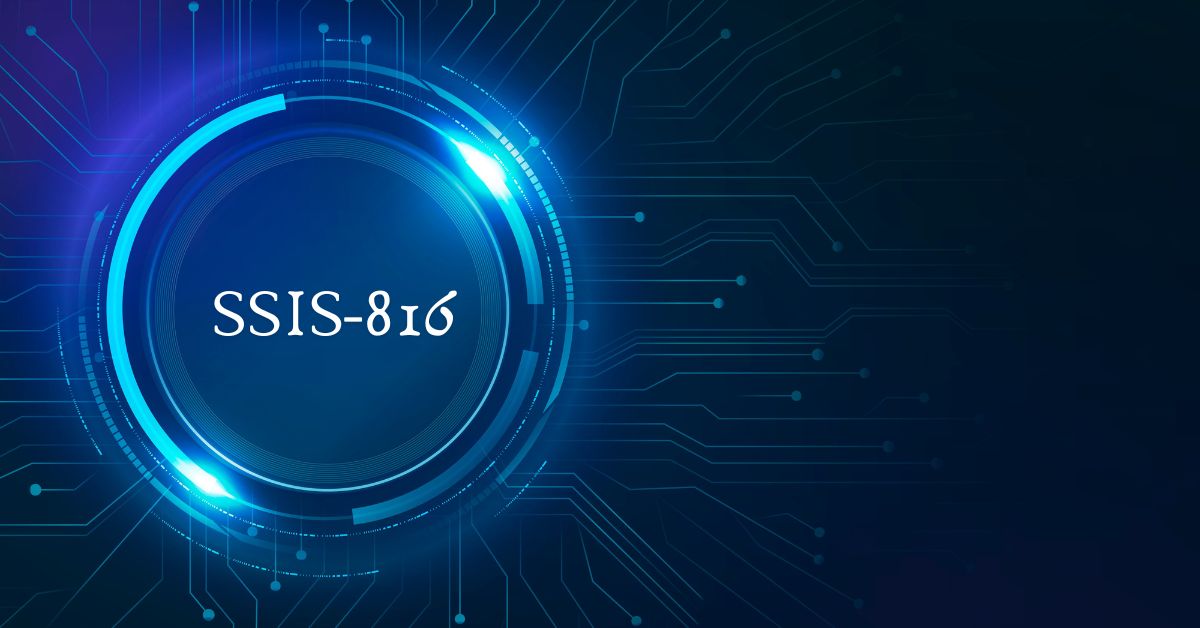SQL Server Integration Services (SSIS) has been an critical tool for builders handling information integration and ETL (Extract, Transform, Load) procedures. With the introduction of SSIS-816, there was lots excitement in the tech community. But what precisely is SSIS-816, and the way does it improve upon previous variations of SSIS? In this text, we’ll dive into what SSIS-816 gives, its structure, use instances, and how it allows businesses cope with complicated information workflows.
What is SSIS-816?
SSIS-816 is the cutting-edge model of SQL Server Integration Services, providing a set of enhancements geared toward simplifying records integration, data migration, and ETL operations. It brings advanced functions, better overall performance, and tighter security, making it a move-to desire for corporations managing massive volumes of information. Whether you’re coping with facts from on-premise servers, cloud environments, or a combination of each, SSIS816 is designed to meet your needs.
Read Must: Understanding Cyanová: A Comprehensive Exploration
Why is it Important?
With extra groups counting on big records and real-time data processing, the want for green and scalable information management equipment has turn out to be essential. SSIS-816 facilitates organizations automate statistics integration methods, enhance performance, and make certain that huge-scale statistics operations run smoothly.
Understanding SSIS (SQL Server Integration Services)
Overview of SSIS
SSIS is a component of Microsoft’s SQL Server database software program, designed to perform records migration and ETL methods. It lets in corporations to combine statistics from distinct sources, apply changes, and keep the processed facts in a vacation spot database.
Role of SSIS in Data Integration
SSIS plays a vital position in records integration, helping businesses unify disparate records systems. Whether you’re merging statistics from a couple of databases, coping with unstructured records, or integrating cloud offerings with on-premise systems, SSIS is an efficient device for the process.
SSIS-816: A New Update?
What’s Special About SSIS-816?
SSIS-816 is packed with new functions aimed toward enhancing scalability and security. With better integration into cloud environments and improved support for actual-time records processing, SSIS-816 stands out as a massive upgrade over previous iterations. It’s ideal for groups running with hybrid records environments and large-scale ETL initiatives.
Key Features of SSIS-816
Improved Performance: SSIS-816 brings optimizations that lessen the time taken for information transfers and transformations.
- Cloud Integration: Seamless integration with Azure and different cloud platforms.
- Enhanced Security: New encryption strategies for information switch and improved access manage mechanisms.
Architecture of SSIS-816
Data Flow Architecture
The records float in SSI816 is designed to be more green, ensuring that statistics actions easily among assets, transformations, and destinations. With the addition of recent transformation functions, SSI permits for faster processing times, even if managing complex datasets.
Control Flow Architecture
SSISs control flow manages the execution of responsibilities and workflows inside a package deal. It provides superior blunders-coping with capabilities and more flexibility in dealing with dependencies, making sure that large-scale information operations can be treated with out bottlenecks.
Key Use Cases for SSIS-816
- Data Migration and Transformation: SSIS816 excels in statistics migration, helping groups flow information among systems seamlessly. Whether you’re migrating to the cloud or consolidating databases, SSI816 can deal with massive volumes of information easily.
- Real-Time Data Processing: With the upward push of actual-time records wishes, SSIS-816 offers answers for processing and transforming facts on the fly, assisting agencies react to modifications quicker.
- ETL Operations: As the backbone of ETL operations, SSIS816 simplifies extracting facts from numerous resources, remodeling it primarily based on enterprise logic, and loading it into a statistics warehouse or different storage answers.
SSIS-816 and ETL (Extract, Transform, Load)
How SSIS-816 Optimizes ETL Processes
SSIS816 streamlines the complete ETL manner with the aid of introducing faster records extraction techniques, extra advanced transformation equipment, and higher assist for diverse data resources. The automation skills additionally help reduce guide intervention.
Best Practices for ETL Using SSIS-816
- Optimize Data Flow: Ensure information flows are well-designed for minimum latency.
- Use Parallel Processing: Leverage the parallelism function to deal with more than one statistics streams simultaneously.
- Regular Maintenance: Monitor and track your SSIS programs frequently to preserve performance.
Enhancements in SSIS-816
Performance Improvements
Performance is one of the standout functions of SSIS It introduces new records compression techniques, optimized execution plans, and better resource allocation to hurry up processing instances.
Integration with Azure and Other Cloud Services
SSIS816 is built with cloud integration in mind. Its tight coupling with Azure Data Factory manner that businesses can effects orchestrate records workflows in hybrid environments, combining on-premises information with cloud storage.
Comparison: SSIS-816 vs. Previous Versions
Major Differences Between SSIS-816 and SSIS-2016
The most sizeable difference between SSIS816 and earlier variations like SSIS-2016 is the enhanced cloud aid and real-time statistics processing talents. SSIS,816 additionally offers a extra intuitive interface, higher logging, and stepped forward debugging tools.
New Features That Make SSIS-816 Stand Out
- Advanced Cloud Features: Deeper integration with Azure and hybrid data environments.
- Improved Real-Time Processing: Faster overall performance and greater responsive records workflows.
Security Features in SSIS-816
Enhanced Data Security
With stricter records compliance requirements, SSIS, introduces more suitable encryption strategies for statistics in transit and at relaxation. This ensures that touchy information remains steady at some stage in the ETL manner.
Secure Data Transfer and Encryption
SSIS employs industry-general encryption strategies like SSL and TDE (Transparent Data Encryption), making sure that information transfers are stable and protected from external threats.
SSIS-816 and Big Data
Handling Large Datasets Efficiently
SSIS is optimized for massive data environments, permitting agencies to deal with massive datasets conveniently. With stepped forward reminiscence control and parallel processing, it can procedure massive quantities of statistics faster than preceding variations.
Integration with Hadoop and Other Big Data Platforms
SSIS can combine with massive statistics systems like Hadoop, allowing agencies to system and examine massive datasets across distributed structures.
SSIS-816 in Cloud Computing
How SSIS-816 Supports Hybrid Cloud Environments
Hybrid cloud environments have become the norm for many corporations. SSIS81[6’s integration with Azure Data Factory and other cloud services makes it simpler to manage information throughout on-premise and cloud systems seamlessly.
SSIS and Azure Data Factory
Azure Data Factory acts as an orchestration layer for SSIS packages in the cloud. With SSIS-816, this integration turns into even greater powerful, taking into account real-time records processing and seamless facts motion among cloud and on-premise environments.
Challenges and Limitations of SSIS-816
Common Issues Faced with the aid of Developers
Despite its many blessings, developers may face troubles together with configuration complexity, bundle control demanding situations, and debugging difficulties in SSIS16.
How to Troubleshoot Problems
Using proper logging, blunders-managing configurations, and overall performance tracking tools can help builders troubleshoot and clear up most troubles in SSIS816.
Best Practices for Implementing SSIS-816
Tips for Smooth Implementation
- Plan the Data Flow: Properly design the facts flow for efficiency.
- Use Error Handling: Ensure strong errors-dealing with mechanisms are in region.
- Test and Monitor: Continuously take a look at and screen overall performance to keep away from potential bottlenecks.
Ensuring Scalability and Performance
To ensure scalability, take benefit of SSIS-816’s parallel processing skills and optimize the facts go with the flow structure for huge-scale operations.
Future of SSIS-816
Expected Updates and Features
With generation evolving unexpectedly, we will anticipate future updates to SSIS 816 to consciousness on deeper AI integration, higher cloud guide, and stepped forward gear for dealing with larger datasets.
The Evolving Role of SSIS in Data Engineering
As groups hold to adopt statistics-pushed techniques, SSIS816 will continue to be a cornerstone for coping with ETL strategies, offering businesses a strong, scalable, and green facts integration device.
Conclusion
SSIS816 brings a wealth of new functions and upgrades that make it an crucial device for current statistics integration duties. From better cloud guide to greater protection and performance, this modern day version is designed to meet the developing needs of today’s information-driven companies. Whether you’re a developer, information engineer, or IT professional, SSIS816 gives the ability and energy needed to streamline your facts workflows.
FAQs
Q: What is SSIS816?
SSIS816 is the modern day model of SQL Server Integration Services, providing improvements in performance, cloud integration, and facts protection.
Q: What are the important thing functions of SSIS816?
Key features consist of more advantageous actual-time statistics processing, cloud integration, and stepped forward performance for ETL operations.
Q: How does SSIS816 differ from earlier versions?
It gives better help for cloud environments, actual-time data, and progressed safety features as compared to SSIS-2016.
Q: Can SSIS816 take care of big records?
Yes, it optimized for coping with huge datasets and integrates with massive records structures like Hadoop.
Q: Is SSIS816 compatible with Azure?
Yes, integrates seamlessly with Azure, allowing agencies to manipulate hybrid cloud statistics environments efficaciously.





















